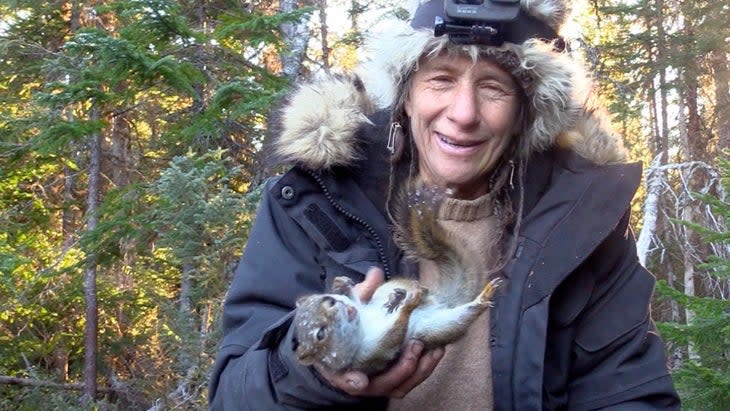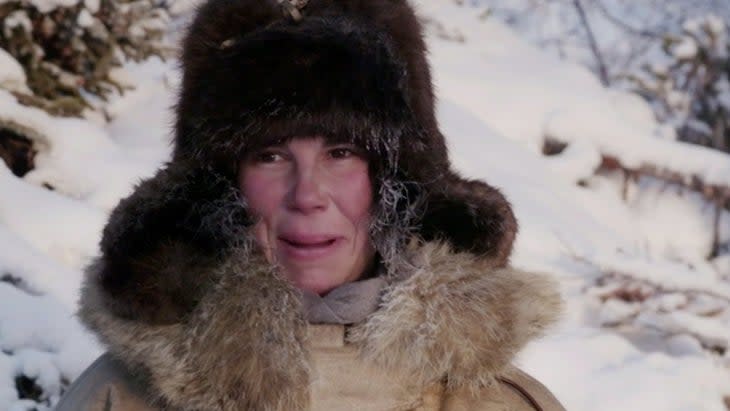Winter Has Arrived on ‘Alone.’ It’s Time to See What These Contestants Are Made Of.
- Oops!Something went wrong.Please try again later.
This article originally appeared on Outside
Let me tell you about my favorite scene from the current season of Alone, a reality television show that is supposed to be about wilderness survival. Spoiler alert: my favorite moment has nothing to do with the wilderness or survival.
In last week's episode, cast member Karie Lee Knoke, a 57-year-old primitive skills instructor from Sandpoint, Idaho, sits in her cold shelter, about to hit the sack after another hungry night without dinner. Up to this point in season nine, Knoke has come across as equal parts Daniel Boone and Stevie Nicks, a blend of hardened outdoors person and soulful bard. As she stares into the darkness, alone with her thoughts, Knoke recounts a painful moment from her past, and the life lesson she has tried to learn from it.
"When I was 36 years old, and when I was four months pregnant, I ended up having a miscarriage, and that's pretty late in the game to have a miscarriage," Knoke says. "I learned that death could happen at any time, and for you to know how to live, you need to know how to die."
The scene previews a series of days in Knoke's life in subarctic Labrador, in which she--like the three other remaining cast members--triumphs and fails at a variety of bushcraft missions. Through each success and setback, Knoke maintains a happy-go-lucky attitude and giant ear-to-ear grin. Her campfire story, however, has added another layer to her character--we now know that Knoke's ability to withstand extreme hunger, freezing temperatures, and soul-sucking isolation is due, at least in some part, to a personal tragedy from 20 years ago.

So, scratch my earlier statement: my favorite scene from this season has everything to do with wilderness, and survival, and adversity, and self realization, and probably 10,000 other things that my puny brain could not process while I watched it unfold. All I could do was feel an intense emotional attachment to Karie Lee Knoke, who now enters the show's pantheon of most compelling cast members.
Prior to watching Alone, I had never expected to absorb wisdom from reality show contestants--especially ones that barbecue rodents and talk endlessly about pooping outdoors. Throughout my reporting on Alone, however, cast members and producers have repeatedly brought up the show's penchant for exploring raw emotion in a way that connects them to the viewers at home. Some cast members have told me that Alone is like going to the longest, coldest, most uncomfortable therapy session ever. When a person is pushed to his or her physical and emotional limits, day after day for months on end, they open up.
Ryan Pender, the show's executive producer, says that these moments of catharsis display what is really driving a person to withstand the discomforts of life in the wild. "At the end of the day, what is most important, and what everybody comes to, is that staying out there is not about the money or the brass ring, it's about family and the relationships you have with your children or mother or father, or lack thereof--that's what everybody can identify with," Pender said. "That's why it's not your traditional survival show."
There are far too many moments of catharsis and emotional release in the Alone series to list them all. In season two, Minnesotan Larry Roberts agonized over his career as an electrician. In season six, Woniya Thibeault talked about being a single woman in her 40s, and the realization that she likely would not have children. In season seven, after surviving 99 days in the woods, Roland Welker spoke about his dead mother, and lamented his inability to connect with her.
"I was like 'Oh my god, they chose to air every scene when I cried, and everybody is going to think I'm a big crybaby,'" Marrone told me.
There is one Alone contestant who stands well above the rest when it comes to catharsis and emotion: Kielyn Marrone (pictured above), a 36-year-old expedition operator from rural Ontario. During season seven, which was held in the frigid subarctic zone around Canada's Great Slave Lake, Marrone wowed viewers with her joyous highs and crushing lows, and her ability to discuss those feelings on camera. I loved Marrone's emotional intelligence, even if many of her scenes involved sobbing.

Marrone told me she was initially shocked when she watched herself on television. "I was like 'Oh my god, they chose to air every scene when I cried, and everybody is going to think I'm a big crybaby,'" Marrone told me. "I think overall, my character was well-portrayed. I'm a loving and emotional person who is also hard on herself. I'm going to wear my heart on my sleeve."
There's a reason why some of Alone's most poignant moments of emotional realization occur later in each season, Marrone says. During the first weeks in the wild, most cast members work from morning until night to build shelter, catch food, and establish hunting grounds and trap lines before temperatures drop. During months two and three, life slows down, temperatures plummet, and food stores dwindle--that's when contestants begin to explore their feelings.
"Things are getting harder and you want to find some form of comfort, but where are you going to find comfort out there?" Marrone says. "You find it in thinking about your mom, or your husband, or your old memories. You spend a lot more time sitting around the fire and you end up going to places that you didn't have time to go to earlier."
During months two and three, life slows down, temperatures plummet, and food stores dwindle, and that's when contestants begin to explore their feelings.
Each contestant's mood is also impacted by the environmental factors, like bad weather, poor sleep, and even access to sunshine. Marrone's encampment was situated adjacent to the lake, and in the colder months, water vapor formed above the water that blocked out sunshine for all but ten minutes or so each day. "As a kid I was pegged as being pretty emotional, and that was with a full stomach and a healthy set of vitamins and lots of sleep and company," Marrone says. "You take a lot of that stuff away and yeah, it can amplify your personality."
But there were specific dynamics at play in Marrone's life that she says also accentuated her emotions. Marrone describes herself as a "touchy-feely person," and the lack of hugs, high-fives, or any other form of human contact had a detrimental impact on her moods. In one scene, Marrone rubbed the severed foot of a dead rabbit on her face in order to feel the fur on her skin.
And Marrone had an added emotional weight during her time on Alone. Her husband, Dave, had also been selected to the initial pool of 20 potential contestants, but he was not chosen as one of the final ten. Marrone says she internalized her husband's disappointment of not being picked, and those feelings came out when she faced setbacks in the woods. "Anytime I'd make a little mistake, I'd be like 'Oh, this is so terrible because Dave wouldn't have done this,'" Marrone says. "Of course that's not true, and Dave was very supportive, but that was a narrative I started to make up and it wasn't good."
Marrone lasted 80 days--far longer than most contestants in the show's history. And, like Karie Lee Knoke, her experience on Alone was about far more than catching critters and building a shelter. That's why Kielyn Marrone and Karie Lee Knoke, and all the other Alone contestants who bare their souls on television, will continue to inspire and entertain me. After all, there are a lot of reality TV shows out there to watch, but not all of them can make you really feel something.
For exclusive access to all of our fitness, gear, adventure, and travel stories, plus discounts on trips, events, and gear, sign up for Outside+ today.

